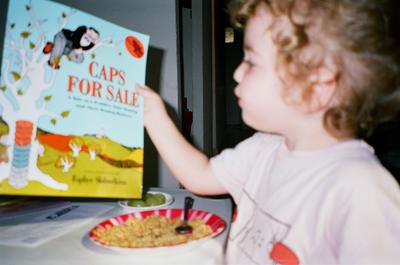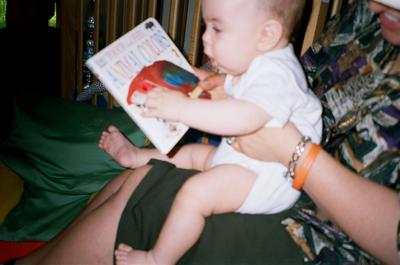

Yes, the illustrations are of my granddaughters!
Hallel is photographed with a classic. I remember my mother reading me Caps for Sale when I was a child, yes, a half a century ago, and I read it to my own children, who are all adults. So I was very happy when my cousin bought a copy for my granddaughter, a new edition but with the same beautiful pictures we loved all those decades ago. Actually, my sister, her two kids and I were with her in Barnes and Nobles when she picked books out for my granddaughters. There was a nice selection of classics, totally irresistible, and we wanted the girls to benefit from the same literature we remembered so fondly.
My cousin told us that she, an art teacher, had used Caps for Sale not long ago when teaching a difficult class of new immigrants who knew very little English. She taught them the story and had them each illustrate a different line. It was a very successful project, but to her amazement, one of the children drew a pile of teacups on the peddler's head.
Since I'm an EFL (English as a Foreign Language) teacher, I guessed immediately. The student couldn't differentiate between a "short u" and a "short a." I come across this problem frequently. And even worse is that they have no idea what the "long vowel" is.
Much too often, kids are taught "a for apple." And if that isn't bad enough, they pronounce it "epple," and it isn't corrected. In Israel, the Education Ministry thinks that "Introduction to English" can be taught by the native-Israeli homeroom teachers who eat "epples," wear "hets" and "hep" on one foot and "hep" that the students will have a good foundation.
My specialty is teaching the weaker students, and by the time they reach me in high school they still have no idea how to differentiate their pronunciations of "hat," "hate," "hut, "hot," etc. Forget about understanding the words, since they all sound the same to them.
I began my EFL career after working in many other professions and only got my certification later. There are advantages to that. I had to figure out ways to teach rather than be dependent on what the "experts" preach.
A friend brought me in to teach in her school and gave me a few minutes of training. She stressed the importance of vowels, and I took off from there.
I had a couple of small groups of high school boys who were missing the most basic skills and dyslexic to boot.
That's how I developed my own methods. First of all, I don't use the terms "long" and "short vowels;" they are "strong" and "weak." "Weak vowels" are surrounded by consonants and can't say their names, like "big" and "cat." "Strong vowels" are helped by their friends and pronounce their name's, like "rope" and "bait." And I teach both pronunciations of the vowel at the same time, so the students are aware, from day one, that there's more than one way to say it.
For correct and accurate reading and spelling, try these techniques.
I love the description of English speakers using only the "e" sound. Our piano teacher is from the Ukraine, and she often says "Two Bleeck (black) keys" She is a great teacher, I just thought it was funny that the "e" sound is so widespread.
ReplyDeleteThanks, your kids are still little, so make sure that they are taught properly.
ReplyDeleteVery interesting concept.
ReplyDeleteIt does work. I find that kids have trouble "relearning" vowels, when the "short and long" aren't taught together.
ReplyDelete